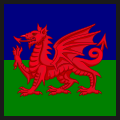| The Royal Welsh | |
|---|---|
 Cap badge of the Royal Welsh | |
| Active | 1 March 2006 – present |
| Country | United Kingdom |
| Branch | British Army |
| Type | Line Infantry |
| Role | 1st Battalion – Armoured Infantry 3rd Battalion – Army Reserve |
| Size | Two battalions |
| Part of | Union Division |
| Garrison/HQ | RHQ – Cardiff 1st Battalion – Tidworth 3rd Battalion – Cardiff |
| Motto(s) | "Ich Dien" (German) "I Serve" "Gwell angau na Chywilydd" (Welsh) ("Better Death than Dishonour") |
| March | Quick – Men of Harlech Slow – Forth to the Battle |
| Mascot(s) | Persian Goat (Shenkin IV) [1] |
| Anniversaries | St David's Day – 1 March |
| Engagements | |
| Commanders | |
| Colonel in Chief | King Charles III |
| Colonel of the Regiment | Maj Gen Chris Barry |
| Insignia | |
| Tactical Recognition Flash |  |
| Hackle | White (ORs only) From Royal Welch Fusiliers |
| Abbreviation | R WELSH |
The Royal Welsh (R WELSH) (Welsh : Y Cymry Brenhinol) is an armoured infantry regiment of the British Army. It was established in 2006 from the Royal Welch Fusiliers (23rd Foot) and the Royal Regiment of Wales (24th/41st Foot).
